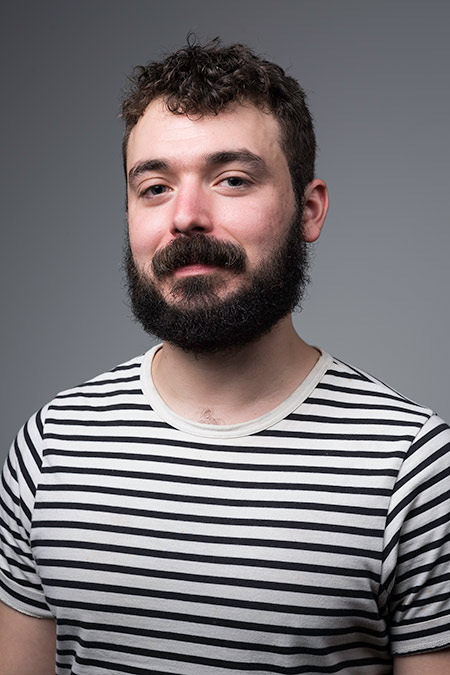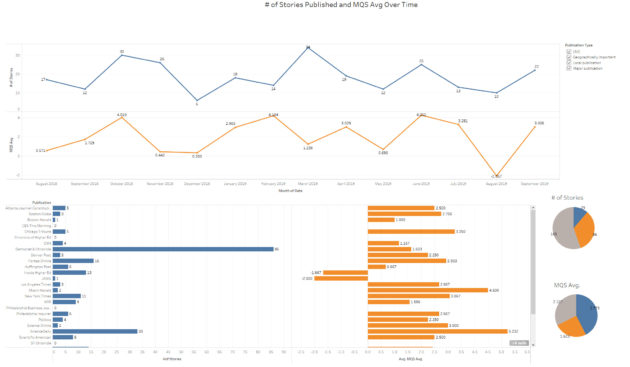
“Everything has patterns,” observes Harrison Frank ’19. And once you recognize that, “the kinds of problems that you are able to solve are everywhere.”
Frank, who graduated from the University of Rochester with a degree in applied mathematics, is now bringing his expertise in pattern recognition to the University’s Office of Communications, where he has served as a data scientist and design researcher since July.
Bridging the gap between data science and communications
The link between data science and communications did not always seem so clear cut.
Frank started as a data science intern in University Communications, a position that did not exist before. The internship was sponsored by the Rochester Data Science Consortium, a research center founded in 2017 to be a catalyst for data science comprehension and adoption in the region.
Just over a year ago, not only were Frank, his internship, and his sponsoring organization all relatively new on campus. So, too, was Frank’s boss.
“I came to the University of Rochester almost two years ago, and, when I did, my role didn’t exist,” says Brian Piper, the director of content strategy and assessment in University Communications. “The University wanted me to start looking at all the communications data that they had. They were collecting a lot of data, but they weren’t using it as effectively as they could, and there were opportunities to integrate the data more fully into their strategic decision-making processes.”
Piper’s office in Wallis Hall was just yards away from Wegmans Hall, home of the Goergen Institute for Data Science. “I had heard about the new and exciting things going on in the [institute],” he says. “I thought, we share the same goal, maybe they can point me in the right direction.” To his surprise, Walt Johnson, the executive director of both the Rochester Data Science Consortium and the Rochester Center of Excellence in Data Science, helped secure a data science intern for University Communications.
“And that is how we met Harrison,” Piper says.
Creating media metrics (and helping your colleagues save time)
“I see it like this: data science and, more specifically, applied mathematics, simply provide a structure for utilizing, recognizing, and formalizing patterns,” says Frank.
As Frank observed Piper, he noticed some patterns in his boss’s work.
“‘You know, I can automate that,” Piper recalls Frank telling him.
Frank’s assistance proved game changing. “Suddenly, reports that I spent three hours on were being updated automatically,” Piper says. “Chunks of my calendar were now free, opened up by simple machine-learning algorithms. Soon I had Harrison speak with all the colleagues in my department. Later, when the period of Harrison’s internship ended, the decision to bring Harrison on full-time was a no brainer.”
“I see my work as investigative listening,” Frank says. “My job is not to dictate how others should work according to our data infrastructure. Rather, it is to learn what objectives others have for their own work and see if we can find a way of using pattern recognition, and other computational methods, to get better at the things that they are already doing.”
Through his ‘investigative listening,’ Frank, in collaboration with Piper and his colleagues in Communications, developed a “Media Quality Score” to assess the value of external media reporting on the University. The metric, comprised of eight key factors, allows the team to better track which stories are enhancing the reputation of the University, which stories are falling flat, and, most importantly, why.
That information offers a valuable guide to the writers, videographers, photographers, and graphic artists whose job it is to help draw attention to the University’s historic and contributions to research, teaching, clinical care, and the arts.
“In reality we are applying the same principles of consumer marketing; however, we are not advertising a product, but rather championing a reputation,” says Piper. “There are a lot of great things happening at the University of Rochester, and not enough people know about it.”
Piper now spends much of his time visiting with the heads of departments around the University and the Medical Center to help them adopt these same strategies. The consortium has sponsored a second data science intern, inside the Medical Center’s communications department.
Frank, meanwhile, is happy to remain for the time being in his role in University Communications. That’s saying a lot, given the opportunities that abound in data science.
“The truth is, I could have gone to Silicon Valley,” he admits, pointing to the considerable draw the Bay Area has on his peers. “But the culture there is: you live there, you eat there, you sleep there, you never go home. You don’t have a life. You kill yourself to achieve someone else’s vision.”
At Rochester, “I have the autonomy to build systems from scratch, learn how these systems are built, and to try things out. We are now in the process of building our data infrastructure from the ground up, and in the process we are learning together.”



